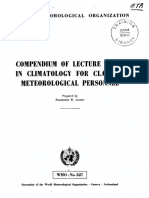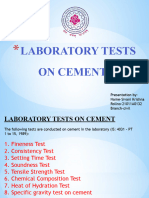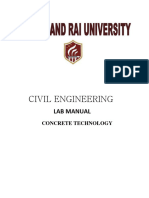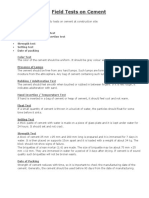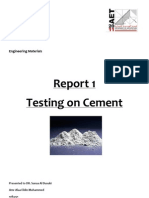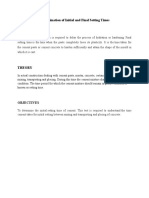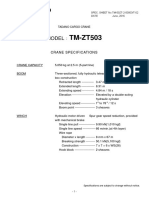Rohini 56951549584
Rohini 56951549584
Uploaded by
Oumar CoulibalyCopyright:
Available Formats
Rohini 56951549584
Rohini 56951549584
Uploaded by
Oumar CoulibalyOriginal Title
Copyright
Available Formats
Share this document
Did you find this document useful?
Is this content inappropriate?
Copyright:
Available Formats
Rohini 56951549584
Rohini 56951549584
Uploaded by
Oumar CoulibalyCopyright:
Available Formats
ROHINI COLLEGE OF ENGINEERING AND TECHNOLOGY
1.3 TESTS ON CEMENT
Testing of cement can be brought under two categories:
o Field testing
o Laboratory testing.
Field Testing
It is sufficient to subject the cement to field tests when it is used for minor works. The
following are the field tests:
Open the bag and take a good look at the cement. There should not be any visible
lumps. The colour of the cement should normally be greenish grey.
Thrust your hand into the cement bag. It must give you a cool feeling. There should
not be lump inside.
Take a pinch of cement and feel-between the fingers. It should give a smooth and
not a gritty feel
Take a handful of cement and throw it on a bucket full of water, the particles should
float for some time before they sink.
Take about 100 grams of cement and a small quantity of water and make a stiff
paste. From the stiff paste, pat a cake with sharp edges. Put it on a glass plate and
slowly take it under water in a bucket. See that the shape of the cake is not disturbed
while taking it down to the bottom of the bucket. After 24 hours the cake should
retain its original shape and at the same time it should also set and attain some
strength.
Laboratory testing:
The following tests are usually conducted in the laboratory.
o Fineness test.
o Setting time test.
o Strength test.
o Soundness test.
CE8404 CONCRETE TECHNOLOGY
ROHINI COLLEGE OF ENGINEERING AND TECHNOLOGY
o Heat of hydration test.
o Chemical composition test.
Fineness Test
The fineness of cement has an important bearing on the rate of hydration and hence on
the rate of gain of strength and also on the rate of evolution of heat. Finer cement offers
a greater surface area for hydration and hence faster the development of strength,
Fineness of cement is tested in two ways:
By sieving.
By determination of specific surface (total surface area of all the particles in one
gram of cement) by air-permeability appartus. Expressed as cm2/gm or m2/kg.
Generally Blaine Air permeability appartus is used
Sieve Test
Weigh correctly 100 grams of cement and take it on a standard IS Sieve No. 9 (90
microns).Break down the air-set lumps in the sample with fingers. Continuously
sieve the sample giving circular and vertical motion for a period of 15 minutes.
Mechanical sieving devices may also be used. Weigh the residue left on the sieve.
This weight shall not exceed 10% f or ordinary cement. Sieve test is rarely used.
1. Air Permeability Method
This method of test covers the procedure for determining the fineness of cement
as represented by specific surface expressed as total surface area in sq. cm/gm. of
cement. It is also expressed in m2/kg. Lea and Nurse Air Permeability Appartus is
shown in Fig. This appartus can be used for measuring the specific surface of
cement.
The principle is based on the relation between the flow of air through the cement
bed and the surface area of the particles comprising the cement bed. From this the
surface area per unit weight of the body material can be related to the permeability
of a bed of a given porosity.
CE8404 CONCRETE TECHNOLOGY
ROHINI COLLEGE OF ENGINEERING AND TECHNOLOGY
The cement bed in the permeability cell is 1 cm. high and 2.5 cm. in diameter.
Knowing the density of cement the weight required to make a cement bed of
porosity of 0.475 can be calculated.
Slowly pass on air through the cement bed at a constant velocity. Adjust the rate
of air flow until the flow meter shows a difference in level of 30-50 cm. Read the
difference in level (h1) of the manometer and the difference in level (h2) of the
flow meter.
Repeat these observations to ensure that steady conditions have been obtained as
shown by a constant value of h1/h2. Specific surface. Fineness can also be
measured by Blain Air Permeability apparatus. This method is more commonly
employed in India.
Standard Consistency Test
For finding out initial setting time, final setting time and soundness of cement, and
strength a parameter known as standard consistency has to be used.
The standard consistency of a cement paste is defined as that consistency which
will permit a Vicat plunger having 10 mm diameter and 50 mm length to penetrate
to a depth of 33-35 mm from the top of the mould .The apparatus is called Vicat
CE8404 CONCRETE TECHNOLOGY
ROHINI COLLEGE OF ENGINEERING AND TECHNOLOGY
Appartus. This appartus is used to find out the percentage of water required to
produce a cement paste of standard consistency or normal consistency.
Procedure:
Take about 500 gm of cement and prepare a paste with a weighed quantity of water
(say 24 per cent by weight of cement) for the first trial.
The paste must be filled into the Vicat mould within 3-5 minutes. After completely
filling the mould, shake the mould to expel air. A standard plunger, 10 mm
diameter, 50 mm long is attached and brought down to touch the surface of the
paste in the test block and quickly released allowing it to sink into the paste by its
own weight.
Take the reading by noting the depth of penetration of the plunger. Conduct a 2nd
trial (say with 25 per cent of water) and find out the depth of penetration of plunger.
Similarly, conduct trials with higher and higher water/cement ratios till such time
the plunger penetrates for a depth of 33-35 mm from the top. That particular
percentage of water which allows the plunger to penetrate only to a depth of 33-35
mm from the top is known as the percentage of water required to produce a cement
paste of standard consistency. This percentage is usually denoted as ‗P‘.
CE8404 CONCRETE TECHNOLOGY
ROHINI COLLEGE OF ENGINEERING AND TECHNOLOGY
The test is required to be conducted in a constant temperature (27° + 2°C) and
constant humidity (90%).
Setting Time Test
Initial Setting Time is the time elapsed between the moments that the water is
added to the cement, to the time that the paste starts losing its plasticity.
The final setting time is the time elapsed between the moment the water is added
to the cement, and the time when the paste has completely lost its plasticity and
has attained sufficient firmness to resist certain definite pressure.
In actual construction dealing with cement paste, mortar or concrete certain time
is required for mixing, transporting, placing, compacting and finishing. During this
time cement paste, mortar, or concrete should be in plastic condition. The time
interval for which the cement products remain in plastic condition is known as the
initial setting time. Normally a minimum of 30 minutes is given for mixing and
handling operations.
Once the concrete is placed in the final position, compacted and finished, it should
lose its plasticity in the earliest possible time so that it is least vulnerable to
damages from external destructive agencies. This time should not be more than 10
hours which is often referred to as final setting time.
Preparation of specimen
o Take 500 gm. of cement sample and guage it with 0.8 5 times the water required
to produce cement paste of standard consistency (0.85 P). The paste shall be
gauged and filled into the Vicat mould in specified manner within 3-5 minutes.
Start the stop watch the moment water is added to the cement. The temperature of
water at the time of gauging shall be within 27°C ± 2°C.
Procedure
INITIAL SETTING TIME.
Lower the needle (C) gently and bring it in contact with the surface of the test block and
quickly release. Allow it to penetrate into the test block and the needle will completely
pierce through the test block. But after some time when the paste starts losing its
CE8404 CONCRETE TECHNOLOGY
ROHINI COLLEGE OF ENGINEERING AND TECHNOLOGY
plasticity, the needle may penetrate only to a depth of 33-35 mm from the top. The period
elapsing between the times when water is added to the cement and the time at which the
needle penetrates the test block to a depth equal to 33-35 mm from the top is taken as
initial setting time.
FINAL SETTING TIME
Replace the needle (C) of the Vicat appartus by a circular attachment (F) The cement
shall be considered as finally set when, upon, lowering the attachment gently over the
surface of the test block, the centre needle makes an impression, while the circular cutting
edge of the attachment fails to do so. In other words the paste has attained the hardness
and the centre needle does not pierce through the paste more than 0.5 mm.
Strength Test
The compressive strength of hardened cement is the most important of all the
properties. Strength tests are not made on neat cement paste because of difficulties of
excessive shrinkage and subsequent cracking of neat cement. Strength of cement is
indirectly found on cement sand mortar in specific proportions.
o The standard sand is used for finding the strength of cement. It shall conform to IS
650-1991. Take 555 gm of standard sand (Ennore sand), 185 gm of cement (i.e.,
ratio of cement to sand is 1:3) in a non-porous enamel tray and mix them with a
trowel for one minute, then add water of quantity + 3.0 per cent of combined
weight of cement and sand and mix the three ingredients thoroughly until the
mixture is of uniform colour.
o The time of mixing should not be less than 3 minutes nor more than 4 minutes.
Immediately after mixing t, he mortar is filled into a cube mould of size 7.06 cm.
The area of the face of the cube will be equal to 50 sq cm.
o Compact the mortar either by hand compaction in a standard specified manner on
the vibrating equipment (12000 RPM) for 2 minutes. Keep the compacted cube in
the mould at a temperature of 27°C ± 2°C and at least 90 per cent relative humidity
for 24 hours. Where the facility of standard temperature and humidity room is not
CE8404 CONCRETE TECHNOLOGY
ROHINI COLLEGE OF ENGINEERING AND TECHNOLOGY
available, the cube may be kept under wet gunny bag to simulate 90 per cent
relative humidity.
o After 24 hours the cubes are removed from the mould and immersed in clean fresh
water until taken out for testing. The periods being reckoned from the completion
of vibration. The compressive strength shall be the average of the strengths of the
three cubes for each period respectively.
Soundness Test
It is very important that the cement after setting shall not undergo any appreciable
change of volume. Certain cements have been found to undergo a large expansion
after setting causing disruption of the set and hardened mass.
This will cause serious difficulties for the durability of structures when such
cement is used. The testing of soundness of cement, to ensure that the cement does
not show any appreciable subsequent expansion is of prime importance.
The unsoundness in cement is due to the presence of excess of lime than that could
be combined with acidic oxide at the kiln. This is also due to inadequate burning
or insufficiency in fineness of grinding or thorough mixing of raw materials. It is
also likely that too high a proportion of magnesium content or calcium sulphate
content may cause unsoundness in cement. For this reason the magnesia content
allowed in cement is limited to 6 per cent. It can be recalled that, to prevent flash
set, calcium sulphate is added to the clinker while grinding.
CE8404 CONCRETE TECHNOLOGY
ROHINI COLLEGE OF ENGINEERING AND TECHNOLOGY
The quantity of gypsum added will vary from 3 to 5 per cent depending upon C3A
content. If the addition of gypsum is more than that could be combined with C3A,
excess of gypsum will remain in the cement in Free State. This excess of gypsum
leads to an expansion and consequent disruption of the set cement paste.
Unsoundness in cement is due to excess of lime, excess of magnesia or excessive
proportion of sulphates. Unsoundness in cement does not come to surface for a
considerable period of time. Therefore, accelerated tests are required to detect it.
There are number of such tests in common use. It consists of a small split cylinder
of spring brass or other suitable metal. It is 30 mm in diameter and 30 mm high.
On either side of the split are attached two indicator arms 165 mm long with
pointed ends.
Cement is gauged with 0.78 times the water required for standard consistency
(0.78P), in a standard manner and filled into the mould kept on a glass plate. The
mould is covered on the top with another glass plate. The whole assembly is
immersed in water at a temperature of 27°C – 32°C and kept there for 24 hours.
Measure the distance between the indicator points. Submerge the mould again in
water. Heat the water and bring to boiling point in about 25-30 minutes and keep
it boiling for 3 hours. Remove the mould from the water, allow it to cool and
measure the distance between the indicator points.
The difference between these two measurements represents the expansion of
cement. This must not exceed 10 mm for ordinary, rapid hardening and low heat
Portland cements. If in case the expansion is more than 10 mm as tested above, the
cement is said to be unsound. The Le Chatelier test detects unsoundness due to free
lime only.
This method of testing does not indicate the presence and after effect of the excess
of magnesia. Indian Standard Specification stipulates that a cement having a
magnesia content of more than 3 per cent shall be tested for soundness by
Autoclave test which is sensitive to both free magnesia and free lime.
In this test a neat cement specimen 25 × 25 mm is placed in a standard autoclave
and the steam pressure inside the autoclave is raised in such a rate as to bring the
CE8404 CONCRETE TECHNOLOGY
ROHINI COLLEGE OF ENGINEERING AND TECHNOLOGY
gauge pressure of the steam to 21 kg/ sq cm in 1 – 11/4 hour from the time the heat
is turned on. This pressure is maintained for 3 hours.
The autoclave is cooled and the length measured again. The high steam pressure
accelerates the hydration of both magnesia and lime. No satisfactory test is
available for deduction of unsoundness due to an excess of calcium sulphate.
1.3.1 IS SPECIFICATIONS
CEMENT
Specifications Minimum Requirements for
OPC as per IS:8112-1989
Specific Gravity 3.15
Fineness (m2/kg) specific surface 225
Setting Time (Initial) 30 min
Setting Time (Final) 600 min
Compressive strength (N/mm2)
3 Days 23
7 Days 33
28 Days 43
Physical properties Grade of cement
33 43 53
Minimum compressive strength at 28 days (N/mm2) 33 43 53
Fineness-minimum specific surface area (m2/kg) 225 225 225
Initial setting time (minimum) 30 min. 30 min. 30 min.
Final setting time (maximum) 600 min. 600 min. 600 min.
Soundness (expansion) in mm 10 10 10
Autoclave test for MgO, percent, maximum 0.8 0.8 0.8
CE8404 CONCRETE TECHNOLOGY
ROHINI COLLEGE OF ENGINEERING AND TECHNOLOGY
Chemical Properties
Loss on ignition (%) 5 5 4
Insoluble residue (%), maximum 4 2 2
Magnesia MgO (%), maximum 6 6 6
SO3 (%) , maximum for C3A > 5 percent 2.5 2.5 2.5
Lime saturation factor (LSF) 0.66-1.02 0.66-1.02 0.8-1.02
Ratio A F minimum 0.66 0.66 0.66
CE8404 CONCRETE TECHNOLOGY
You might also like
- Cellular Respiration: An Overview: Lesson SummaryDocument10 pagesCellular Respiration: An Overview: Lesson Summaryandrea plalu29% (7)
- GCAF Online Inspector Practice ExamDocument5 pagesGCAF Online Inspector Practice Examcamwills250% (2)
- WMO Lecture Notes For Class IV Meteorological PersonnelDocument165 pagesWMO Lecture Notes For Class IV Meteorological PersonnelLuke HNo ratings yet
- Chapter 3 MethodologyDocument22 pagesChapter 3 MethodologySiva KrishnaNo ratings yet
- Experiment No. 1 Consistency Test On CementDocument8 pagesExperiment No. 1 Consistency Test On CementAjinkya Shendarkar67% (3)
- Test For Properties of Cement: Physical & ChemicalDocument4 pagesTest For Properties of Cement: Physical & ChemicalmuqeetNo ratings yet
- Presentation 1Document22 pagesPresentation 1MEHALANo ratings yet
- Unit 1 Handout # 3Document6 pagesUnit 1 Handout # 3Oumar CoulibalyNo ratings yet
- Tests On CementDocument138 pagesTests On CementKalasekar M Swamy50% (2)
- CTM 1Document7 pagesCTM 1Sajil KrishnaNo ratings yet
- Consistency of Standard Cement PasteDocument53 pagesConsistency of Standard Cement PasteLakshay SinghalNo ratings yet
- Determination of Consistency of Standard Cement PasteDocument3 pagesDetermination of Consistency of Standard Cement PasteAfifah FauziNo ratings yet
- CementsDocument11 pagesCementsmd nasirNo ratings yet
- Fineness Test On CementDocument13 pagesFineness Test On CementTvsp Sekhar50% (2)
- PUSA Concrete Lab ManualDocument51 pagesPUSA Concrete Lab Manualaryanguptabhadara6No ratings yet
- Concrete Technology (Lab Manual)Document23 pagesConcrete Technology (Lab Manual)VipulShukla100% (3)
- Concrete-Technology-Lab MINIMAL EDITEDDocument20 pagesConcrete-Technology-Lab MINIMAL EDITEDsidNo ratings yet
- Laboratory TestsDocument13 pagesLaboratory TestsSivani KrishnaNo ratings yet
- Lab ManualDocument23 pagesLab ManualSuraj AgrawalNo ratings yet
- Dip4th-CE CT LAB MANUALDocument28 pagesDip4th-CE CT LAB MANUALkuldeep barman CE 076No ratings yet
- ConcreteDocument131 pagesConcreteHimanshu BhardwajNo ratings yet
- Normal Consistancy and Settling Lab ManualDocument4 pagesNormal Consistancy and Settling Lab ManualAnonymous gQzqEs3No ratings yet
- Factors Affecting The Quality of Cement and Testing of CementDocument21 pagesFactors Affecting The Quality of Cement and Testing of CementMadhanNo ratings yet
- Test On Cement PDFDocument6 pagesTest On Cement PDFIrfan NazirNo ratings yet
- Concrete Technology LABDocument52 pagesConcrete Technology LABBanoth Manjula SonuNo ratings yet
- Basic Civil Engineering Lab-2-1Document8 pagesBasic Civil Engineering Lab-2-1KUNDAN SHARMANo ratings yet
- CT Lab ManualDocument26 pagesCT Lab ManualJagathChandraNo ratings yet
- Lju CT Lab Manual Dku FinalDocument52 pagesLju CT Lab Manual Dku FinalAryan RathodNo ratings yet
- CT labDocument32 pagesCT labjd2saiNo ratings yet
- Cement Concrete Hollow Block and ConcreteDocument99 pagesCement Concrete Hollow Block and ConcreteEchanez, Gem Krian0% (1)
- cement pdfDocument14 pagescement pdfsuraj AkulwarNo ratings yet
- Report 1 Testing On Cement: Engineering MaterialsDocument9 pagesReport 1 Testing On Cement: Engineering MaterialsEman SalahNo ratings yet
- Cement TestingDocument5 pagesCement TestingLATRELL CASTRONo ratings yet
- Presentation On ConcreteDocument26 pagesPresentation On Concreteaditya thakare100% (1)
- Concrete Lab Report 6Document11 pagesConcrete Lab Report 6Prabu SilentgateNo ratings yet
- Cement PPT ArunDocument10 pagesCement PPT ArunAbhishek SharmaNo ratings yet
- MVSE-106 Lab-II CONCRETE LABDocument55 pagesMVSE-106 Lab-II CONCRETE LABABHISHEK PANDYANo ratings yet
- Tests On CementDocument24 pagesTests On CementIan BondocNo ratings yet
- Concrete Technology - Practical Lab ManualDocument32 pagesConcrete Technology - Practical Lab Manualjd2saiNo ratings yet
- CT 3 PDFDocument26 pagesCT 3 PDFJay PatelNo ratings yet
- Building Science Lab ManualDocument23 pagesBuilding Science Lab Manualshantnu iluNo ratings yet
- Concrete Technology Notes 2Document10 pagesConcrete Technology Notes 2Munir HalimzaiNo ratings yet
- 5 Materials of Cement ConcreteDocument27 pages5 Materials of Cement ConcretesetumehtaNo ratings yet
- Cemetn TestingDocument20 pagesCemetn TestingKrishnan SubramaniamNo ratings yet
- Wa0019.Document21 pagesWa0019.Yash PatelNo ratings yet
- CT Lab ManualDocument50 pagesCT Lab ManualkabirdhivarNo ratings yet
- Lab Manual.1pdfDocument31 pagesLab Manual.1pdfAshish KumarNo ratings yet
- Durgesh CementDocument43 pagesDurgesh Cementpandeydurgesh996No ratings yet
- Final 2.concrete and Highway Lab - PU R9 PDFDocument119 pagesFinal 2.concrete and Highway Lab - PU R9 PDFSanthoshMBSanthuNo ratings yet
- CT Lab ManualDocument46 pagesCT Lab Manualajay.shindeNo ratings yet
- Sci1103 Unit 4notesDocument84 pagesSci1103 Unit 4notesSalin RajNo ratings yet
- Muddasar Ahmed (Cms Id 6139) Material Engineering Lab PracticalsDocument15 pagesMuddasar Ahmed (Cms Id 6139) Material Engineering Lab PracticalsAafaq Ur RehmanNo ratings yet
- Cte Unit-1Document36 pagesCte Unit-14bitgmrNo ratings yet
- 05) CE 304 Lec 3 (Compatibility Mode)Document21 pages05) CE 304 Lec 3 (Compatibility Mode)priyadarshanNo ratings yet
- Materialogi: Material Used For Rigid PavementDocument11 pagesMaterialogi: Material Used For Rigid PavementMk ModiNo ratings yet
- Adobe Scan 25 Nov 2024Document15 pagesAdobe Scan 25 Nov 2024abhishekchauhan5764No ratings yet
- Standard Consistency, Setting Time,, and Fineness of CementDocument6 pagesStandard Consistency, Setting Time,, and Fineness of CementNur Syahira0% (1)
- Material Testing ManualDocument56 pagesMaterial Testing ManualJithin Benny JithinNo ratings yet
- Sewage Disposal Works: Their Design and ConstructionFrom EverandSewage Disposal Works: Their Design and ConstructionNo ratings yet
- Setting Time and Standard Consistency of Quaternary Binders: The in Uence of Cementitious Material Addition and MixingDocument7 pagesSetting Time and Standard Consistency of Quaternary Binders: The in Uence of Cementitious Material Addition and MixingOumar CoulibalyNo ratings yet
- 37309021898Document2 pages37309021898Oumar CoulibalyNo ratings yet
- Material Testing Lab ManualDocument35 pagesMaterial Testing Lab ManualOumar CoulibalyNo ratings yet
- IntéressantDocument7 pagesIntéressantOumar CoulibalyNo ratings yet
- CementLaboratoryManual 10040391Document134 pagesCementLaboratoryManual 10040391Oumar CoulibalyNo ratings yet
- Mortars For Brickwork - Selection and Quality Assurance: Technical Notes 8BDocument7 pagesMortars For Brickwork - Selection and Quality Assurance: Technical Notes 8BOumar CoulibalyNo ratings yet
- Concrete Laboratory ManualDocument4 pagesConcrete Laboratory ManualOumar CoulibalyNo ratings yet
- Material Testing (1) (001-312) Compressed (1) CompressedDocument312 pagesMaterial Testing (1) (001-312) Compressed (1) CompressedOumar CoulibalyNo ratings yet
- Month Wise Operator Utilization AreaDocument4 pagesMonth Wise Operator Utilization AreaNitta MallikNo ratings yet
- Chapter 19 Partial Fractions: EXERCISE 81 Page 181Document10 pagesChapter 19 Partial Fractions: EXERCISE 81 Page 181Fritz FatigaNo ratings yet
- Cytoarchitecture 2014Document50 pagesCytoarchitecture 2014Sinisa Ristic100% (1)
- IIT Guwahati Anthropometric Data2Document1 pageIIT Guwahati Anthropometric Data2praveen karunanithiNo ratings yet
- Instructions For Pro Climb and Pro Cross 800 Turbo Kits Stage 2Document21 pagesInstructions For Pro Climb and Pro Cross 800 Turbo Kits Stage 2cpcracingNo ratings yet
- BE Sem-2 Unit 1 Introduction To Business EnvironmentDocument23 pagesBE Sem-2 Unit 1 Introduction To Business EnvironmentAmbarish VaghelaNo ratings yet
- OSP Engineer - Ronaldo RomeroDocument11 pagesOSP Engineer - Ronaldo RomeroOchie RomeroNo ratings yet
- UT8Q6zYXdpcXXc PVBXFDocument5 pagesUT8Q6zYXdpcXXc PVBXFOsama YaseenNo ratings yet
- Parts Manual Parts Manual Parts Manual Parts Manual: Mfg. No: 196432-0070-02Document39 pagesParts Manual Parts Manual Parts Manual Parts Manual: Mfg. No: 196432-0070-02Gerardo T.R.No ratings yet
- High Density Apitong Cross Arm BracesDocument4 pagesHigh Density Apitong Cross Arm BracesShahriar AhmedNo ratings yet
- Grade8 Q1 4 W5 6 Occupational HealthDocument21 pagesGrade8 Q1 4 W5 6 Occupational HealthMaribel G. MontiarNo ratings yet
- Planned 2024 CoursesDocument2 pagesPlanned 2024 CourseshasanalitktoNo ratings yet
- Visions - of - The - Future - 2030 DbschenkerDocument53 pagesVisions - of - The - Future - 2030 DbschenkerAdhi GunarwanNo ratings yet
- Shanay LN - Resume 22-23Document2 pagesShanay LN - Resume 22-23api-660774784No ratings yet
- Effectiveness of Five Antidandruff Cosmetic Formulations Against Planktonic Cells and Biofilms of DermatophytesDocument7 pagesEffectiveness of Five Antidandruff Cosmetic Formulations Against Planktonic Cells and Biofilms of Dermatophytesjeane wattimenaNo ratings yet
- Drug Name Action Dose & Route Side Effects Nursing Care Brand Name: Twynsta Generic: Telmisartan + AmlodipineDocument4 pagesDrug Name Action Dose & Route Side Effects Nursing Care Brand Name: Twynsta Generic: Telmisartan + AmlodipineEileenAquinoMacapagalNo ratings yet
- frenos-INTORQ BFK457 Erhsa2013 PDFDocument16 pagesfrenos-INTORQ BFK457 Erhsa2013 PDFCarlos CalloNo ratings yet
- E-Marking Notes On Biology HSSC I May 2017Document33 pagesE-Marking Notes On Biology HSSC I May 2017Qudsia AbrarNo ratings yet
- MT2010 Battery 2018-03Document8 pagesMT2010 Battery 2018-03Yosmar TorrealbaNo ratings yet
- Seed Science and TechnologyDocument222 pagesSeed Science and TechnologyTwishaNo ratings yet
- Food Grade Metal UseDocument3 pagesFood Grade Metal UseIPMANo ratings yet
- TM-ZT503: ModelDocument5 pagesTM-ZT503: ModelYudha SetiawanNo ratings yet
- Bahasa Inggris Kelas XIIDocument8 pagesBahasa Inggris Kelas XIIDekrit Feryzon Peter Kusuma50% (2)
- Hey Im SaulDocument10 pagesHey Im SaulArmando COntreras100% (1)
- XI-English Annual 2021Document14 pagesXI-English Annual 2021mrityunjayNo ratings yet
- Lesson Exemplar Sagisag Kultura Grade6 Mathematics PDFDocument20 pagesLesson Exemplar Sagisag Kultura Grade6 Mathematics PDFGregorio Manuel DonNo ratings yet
- HVAC Fundamentals & TestingDocument376 pagesHVAC Fundamentals & Testing1amonet2100% (5)



